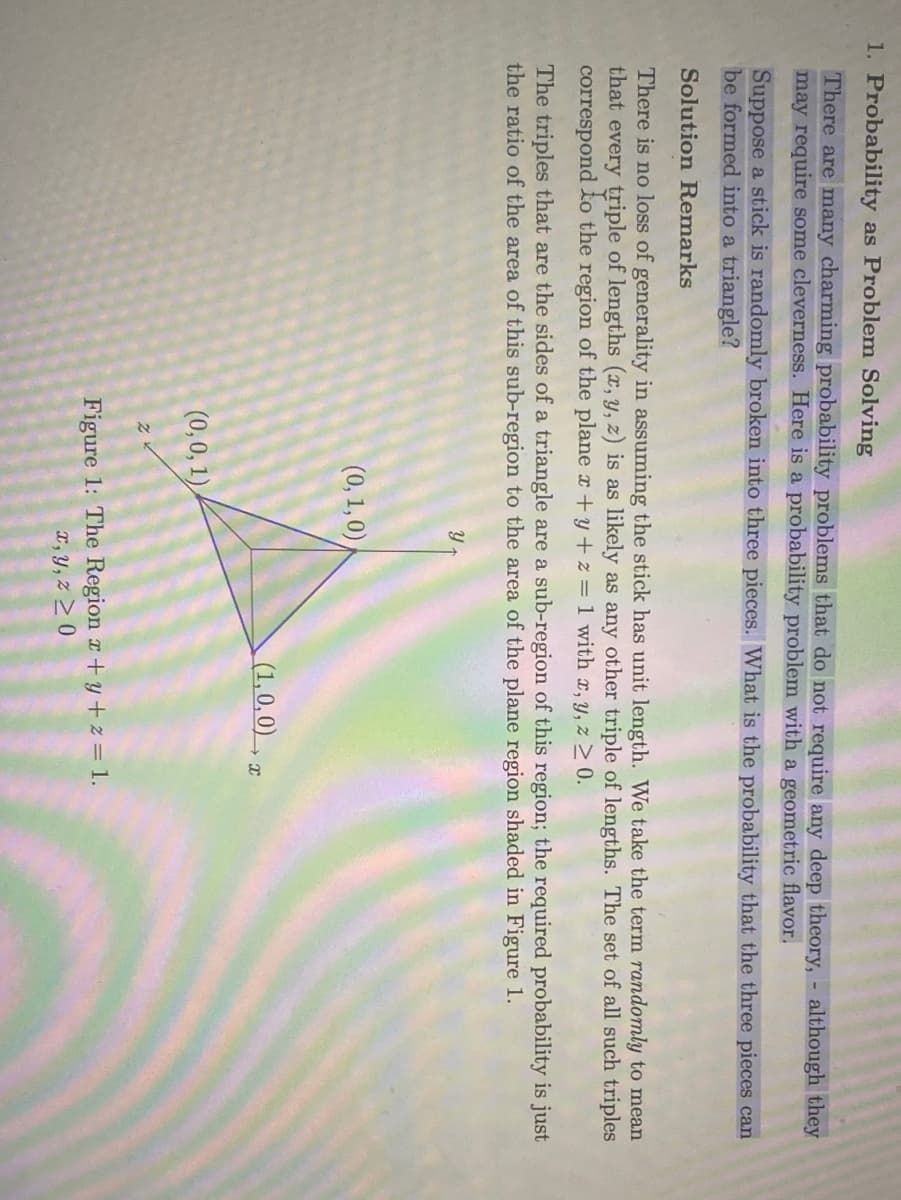Suppose a stick is randomly broken into three pieces. What is the probability that the three pieces can be formed into a triangle?
Suppose a stick is randomly broken into three pieces. What is the probability that the three pieces can be formed into a triangle?
College Algebra
7th Edition
ISBN:9781305115545
Author:James Stewart, Lothar Redlin, Saleem Watson
Publisher:James Stewart, Lothar Redlin, Saleem Watson
Chapter9: Counting And Probability
Section: Chapter Questions
Problem 7CC
Related questions
Question

Transcribed Image Text:1. Probability as Problem Solving
There are many charming probability problems that do not require any deep theory, although they
may require some cleverness. Here is a probability problem with a geometric flavor.
Suppose a stick is randomly broken into three pieces. What is the probability that the three pieces can
be formed into a triangle?
Solution Remarks
There is no loss of generality in assuming the stick has unit length. We take the term randomly to mean
that every triple of lengths (x, y, z) is as likely as any other triple of lengths. The set of all such triples
correspond to the region of the plane x+y+z = 1 with x, y, z 2 0.
The triples that are the sides of a triangle are a sub-region of this region; the required probability is just
the ratio of the area of this sub-region to the area of the plane region shaded in Figure 1.
(0, 1,0)
(1,0,0) , æ
(0,0, 1)
Figure 1: The Region r+y+z = 1.
x, y, z > 0
Expert Solution
This question has been solved!
Explore an expertly crafted, step-by-step solution for a thorough understanding of key concepts.
This is a popular solution!
Trending now
This is a popular solution!
Step by step
Solved in 2 steps with 1 images

Recommended textbooks for you

College Algebra
Algebra
ISBN:
9781305115545
Author:
James Stewart, Lothar Redlin, Saleem Watson
Publisher:
Cengage Learning

Holt Mcdougal Larson Pre-algebra: Student Edition…
Algebra
ISBN:
9780547587776
Author:
HOLT MCDOUGAL
Publisher:
HOLT MCDOUGAL

Algebra and Trigonometry (MindTap Course List)
Algebra
ISBN:
9781305071742
Author:
James Stewart, Lothar Redlin, Saleem Watson
Publisher:
Cengage Learning

College Algebra
Algebra
ISBN:
9781305115545
Author:
James Stewart, Lothar Redlin, Saleem Watson
Publisher:
Cengage Learning

Holt Mcdougal Larson Pre-algebra: Student Edition…
Algebra
ISBN:
9780547587776
Author:
HOLT MCDOUGAL
Publisher:
HOLT MCDOUGAL

Algebra and Trigonometry (MindTap Course List)
Algebra
ISBN:
9781305071742
Author:
James Stewart, Lothar Redlin, Saleem Watson
Publisher:
Cengage Learning

Algebra & Trigonometry with Analytic Geometry
Algebra
ISBN:
9781133382119
Author:
Swokowski
Publisher:
Cengage